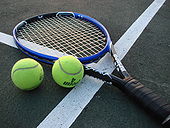- Types of tennis match
-
Traditionally, tennis is played between two people in a singles match, or two pairs in a doubles match.
Contents
Standard types of match
Singles involves two players competing against each other, usually two men or two women, although games between a man and a woman may be played on an informal basis.
Doubles is played by two players of two teams each, most often all-male or all-female. It utilizes a wider court than singles matches: it includes the area in the alley (tramlines, in British terminology), whereas singles does not. The two players on the receiving side change positions after each point played (one at the net and the other near the baseline, preparing to return serve).
Mixed doubles is played the same as doubles, but with each team comprising one man and one woman. This form of tennis is rare in the professional game, due to the men's and women's tours being organised separately (by the ATP and WTA respectively). However, all four Grand Slam tournaments hold a mixed doubles competition, alongside the men's and women's doubles, and featuring many of the same players. There is also an annual mixed tournament for national teams, the Hopman Cup, which includes mixed doubles. Additionally, tennis at the 2012 Summer Olympics will include a mixed doubles event for the first time since tennis returned to the Olympic Games in 1988.
In professional tennis tournaments such as Wimbledon, the singles competition receives the most prize money and coverage, followed by doubles, with mixed doubles usually receiving the least monetary awards. [1] Also while players are gradually less competitive in singles by their late 20s and early 30s, they can still continue competitively in doubles, such as Martina Navratilova and John McEnroe who won doubles titles in their 40s.
Other types of match
Canadian doubles
Main article: Canadian doublesWhen three players are available, modified rules can accommodate the mismatch so that the single player does not have to be significantly better than the double team. The single player hits into a doubles court while the side with two players hits into a singles court.
Australian doubles
An informal and unsanctioned form of tennis, this is played with similar rules to Canadian doubles, only in this version, players rotate court position after each game. As such, each player plays doubles and singles over the course of a match, with the singles player always serving. Scoring styles vary, but one popular method is to assign a value of 2 points to each game, with the server taking both points if he or she holds serve, and the doubles team each taking one if they break. Confusingly, throughout Australia this format is usually known as "American doubles".[citation needed]
Jordache tennis
A game played between three players. A normal tennis game takes place between two of the three contestants. Players are awarded 5 points for a game win and the loser is awarded points based on the score achieved: 3 for deuce, 2 for 30 and 1 for 15. The winner remains in. The player replacing the loser gets to choose who serves. The first to 50 wins. Scoring is calculated continuously, so if a player is currently on 49 points at the start of a game they only have to win one point for the game to end. There is a variation invented in 2005, called "mini-Jordache", where the winner is the first to 25.[2]
Wheelchair tennis
Main article: Wheelchair tennisPlayed in both singles and doubles forms by people in wheelchairs. The main difference is that the ball may bounce twice before it is hit, the second bounce may even be outside the court. All four Grand Slam tournaments include wheelchair tennis.
T31
Played in singles under the following rules:
- Players play 31 points.
- It is not the first to get 16. All 31 points are played so that simultaneously played games finish together.
- Players change ends after 16 points and change serve after each five points.
- A player has one serve and no lets.
- The server must move inside the service line for his fifth stroke.
- Format is an eight-person compass draw. With each game lasting about 15 minutes, an entire tournament of three rounds can be played on four courts in under an hour.
- Additional prize for the player with the most points so eliminated players still have incentive.[3]
This variation is the brainchild of Tennis North (Tasmania) president Tennis Tucker.
See also
References
- ^ "Wimbledon Prize Money". Associated Press. Archived from the original on Apr 19, 2011. http://sports.yahoo.com/tennis/news?slug=ap-wimbledonprizemoneylist. Retrieved 29 June 2011.
- ^ http://www.feekhok.com/matches-type.html
- ^ [1]
Tennis Background and glossary 
Grand Slams Professional tours Tennis shots Ace · Backhand · Backspin · Drop shot · Flat · Forehand · Groundstroke · Half volley · Lob · Serve · Overhead smash · Topspin · Volley · Passing shotTennis strategy and techniques Tennis courts and surfaces Equipment Tennis technology Team events Other Categories:- Tennis
- Forms of tennis
- Tennis terminology
Wikimedia Foundation. 2010.
